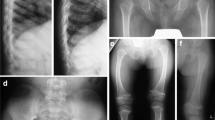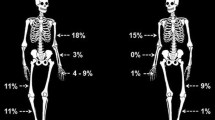Abstract
The aim of the present study was to investigate the possible influence of low-density lipoprotein receptor-related protein 5 (LRP5) and sclerostin (SOST) genes as genetic factors contributing to calcaneal quantitative ultrasound (QUS) and body composition variables in a population of young Caucasian adults. The study population comprised a total of 575 individuals (mean age 20.41years; SD 2.36) whose bone mass was assessed through QUS to determine broadband ultrasound attenuation (BUA, dB/MHz). Body composition measurements were performed using a body composition analyser. Seven single-nucleotide polymorphisms (SNPs) of LRP5 (rs2306862, rs599083, rs556442 and rs3736228) and SOST (rs4792909, rs851054 and rs2023794) were selected as genetic markers and genotyped using TaqMan OpenArray® technology. Linear regression analysis was used to test the possible association of the tested SNPs with QUS and body composition parameters. Linear regression analysis revealed that the rs3736228 SNP of LPR5 was significantly associated with BUA after adjustment for age, sex, weight, height, physical activity and calcium intake (P = 0.028, β (95% CI) = 0.089 (0.099–1.691). For the remaining SNPs, no significant association with the QUS measurement was observed. Regarding body composition, no significant association was found between LRP5 and SOST polymorphisms and body mass index, total fat mass and total lean mass after adjustment for age and sex as covariates. We concluded that the rs3736228 LRP5 genetic polymorphism influences calcaneal QUS parameter in a population of young Caucasian adults. This finding suggests that LRP5 might be an important genetic marker contributing to bone mass accrual early in life.
Similar content being viewed by others
References
Krieg MA, Barkmann R, Gonnelli S et al (2008) Quantitative ultrasound in the management of osteoporosis: the 2007 ISCD Official Positions. J Clin Densitom 11:163–187
Gregg EW, Kriska AM, Salamone LM et al (1997) The epidemiology of quantitative ultrasound: a review of the relationships with bone mass, osteoporosis and fracture risk. Osteoporos Int 7:89–99
Karasik D, Hsu YH, Zhou Y et al (2010) Genome-wide pleiotropy of osteoporosis-related phenotypes: the Framingham study. J Bone Miner Res 25:1555–1563
Howard GM, Nguyen TV, Harris M et al (1998) Genetic and environmental contributions to the association between quantitative ultrasound and bone mineral density measurements: a twin study. J Bone Miner Res 13:1318–1327
Glass DA, Bialek P, Ahn JD et al (2005) Canonical Wnt signaling in differentiated osteoblasts controls osteoclast differentiation. Dev Cell 8:751–764
Gong Y, Slee RB, Fukai N et al (2001) LDL receptor-related protein 5 (LRP5) affects bone accrual and eye development. Cell 107:513–523
Baron R, Rawadi G (2007) Targeting the Wnt/beta-catenin pathway to regulate bone formation in the adult skeleton. Endocrinology 148:2635–2643
Li X, Zhang Y, Kang H et al (2005) Sclerostin binds to LRP5/6 and antagonizes canonical Wnt signaling. J Biol Chem 280:19883–19887
Estrada K, Styrkarsdottir U, Evangelou E (2012) Genome-wide meta-analysis identifies 56 bone mineral density loci and reveals 14 loci associated with risk of fracture. Nat Genet 44:491–501
Richards J, Rivadeneira F, Inouye M et al (2008) Bone mineral density, osteoporosis, and osteoporotic fractures: a genome-wide association study. Lancet 371:1505–1512
Tran BNH, Nguyen ND, Eisman JA, Nguyen TV (2008) Association between LRP5 polymorphism and bone mineral density: a Bayesian meta-analysis. BMC Med Genet 9:55
Styrkarsdottir U, Halldorsson BV, Gretarsdottir S et al (2009) New sequence variants associated with bone mineral density. Nat Genet 41:15–17
Styrkarsdottir U, Halldorsson BV, Gudbjartsson DF et al (2010) European bone mineral density loci are also associated with BMD in East-Asian populations. PLoS One 5:e13217
Yerges LM, Klei L, Cauley JA et al (2009) High-density association study of 383 candidate genes for volumetric BMD at the femoral neck and lumbar spine among older men. J Bone Miner Res 24:2039–2049
Richards JB, Kavvoura FK, Rivadeneira F et al (2009) Collaborative meta-analysis: associations of 150 candidate genes with osteoporosis and osteoporotic fracture. Ann Intern Med 151:528–537
Xiong D-H, Lei S-F, Yang F et al (2007) Low-density lipoprotein receptor-related protein 5 (LRP5) gene polymorphisms are associated with bone mass in both Chinese and whites. J Bone Miner Res 22:385–393
Moayyeri A, Hsu Y-H, Karasik D et al (2014) Genetic determinants of heel bone properties: genome-wide association meta-analysis and replication in the GEFOS/GENOMOS consortium. Hum Mol Genet 23:3054–3068
Horváth P, Balla B, Kósa JP et al (2016) Strong effect of SNP rs4988300 of the LRP5 gene on bone phenotype of Caucasian postmenopausal women. J Bone Miner Metab 34:79–85
Kumar J, Swanberg M, McGuigan F et al (2011) LRP4 association to bone properties and fracture and interaction with genes in the Wnt- and BMP signaling pathways. Bone 49:343–348
Saarinen A, Välimäki V-V, Välimäki MJ et al (2007) The A1330 V polymorphism of the low-density lipoprotein receptor-related protein 5 gene (LRP5) associates with low peak bone mass in young healthy men. Bone 40:1006–1012
Ross SE, Hemati N, Longo KA et al (2000) Inhibition of adipogenesis by Wnt signaling. Science 289:950–953
Bennett CN, Ross SE, Longo KA et al (2002) Regulation of Wnt signaling during adipogenesis. J Biol Chem 277:30998–31004
Lin H, Luo Q, He C et al (2010) On correlation between body mass index and lumbar spine average bone mineral density: a study in male patients with osteopenia and those with osteoporosis. Sheng Wu Yi Xue Gong Cheng Xue Za Zhi 27:138–141
Tóth E, Ferenc V, Mészáros S et al (2005) Effects of body mass index on bone mineral density in men. Orv Hetil 146:1489–1493
Piters E, de Freitas F, Nielsen TL et al (2012) Association study of polymorphisms in the SOST gene region and parameters of bone strength and body composition in both young and elderly men: data from the Odense Androgen Study. Calcif Tissue Int 90:30–39
Ashouri E, Meimandi EM, Saki F et al (2015) The impact of LRP5 polymorphism (rs556442) on calcium homeostasis, bone mineral density, and body composition in Iranian children. J Bone Miner Metab 33:651–657
Yu J, Ke Y, He J et al (2010) No association between LRP5 gene polymorphisms and bone and obesity phenotypes in Chinese male-offspring nuclear families. Acta Pharmacol Sin 31:1464–1469
Guo Y, Xiong D, Shen H et al (2006) Polymorphisms of the low-density lipoprotein receptor-related protein 5 (LRP5) gene are associated with obesity phenotypes in a large family-based association study. J Med Genet 43:798–803
Craig CL, Marshall AL, Sjostrom M, Bauman AE, Booth ML, Ainsworth BE, Pratt M, Ekelund U, Yngve A, Salis J, Oja P (2003) International physical activity questionnaire: 12 country reliability and validity. Med Sci Sport Exerc 35:3508-1381
Töyräs J, Nieminen MT, Kröger H, Jurvelin JS (2002) Bone mineral density, ultrasound velocity, and broadband attenuation predict mechanical properties of trabecular bone differently. Bone 31:503–507
Sims A-M, Shephard N, Carter K et al (2008) Genetic analyses in a sample of individuals with high or low BMD shows association with multiple Wnt pathway genes. J Bone Miner Res 23:499–506
Ferrari SL, Deutsch S, Choudhury U et al (2004) Polymorphisms in the low-density lipoprotein receptor-related protein 5 (LRP5) gene are associated with variation in vertebral bone mass, vertebral bone size, and stature in whites. Am J Hum Genet 74:866–875
Cheung C-L, Huang Q-Y, Chan V, Kung AWC (2008) Association of low-density lipoprotein receptor-related protein 5 (LRP5) promoter SNP with peak bone mineral density in Chinese women. Hum Hered 65:232–239
Canto-Cetina T, Polanco Reyes L, González Herrera L et al (2013) Polymorphism of LRP5, but not of TNFRSF11B, is associated with a decrease in bone mineral density in postmenopausal maya-mestizo women. Am J Hum Biol 25:713–718
Markatseli AE, Hatzi E, Bouba I et al (2011) Association of the A1330 V and V667 M polymorphisms of LRP5 with bone mineral density in Greek peri- and postmenopausal women. Maturitas 70:188–193
Acknowledgements
This study was supported by Grant PP2014-11 from ‘Pre-competitive Research Projects Program’ (Granada University) and in part by Grant PI-0414-2014 from Consejería de Salud (Junta de Andalucía). Correa-Rodríguez M is a predoctoral fellow (FPU13/00143) from the Ministerio de Educación, Cultura y Deporte (Programa de Formación del Profesorado Universitario). We would like to thank technical support provided by staff of the Genomics and Genotyping Unit of GENyO (Granada).
Author information
Authors and Affiliations
Corresponding author
Ethics declarations
All procedures performed in studies involving human participants were in accordance with the ethical standards of the institutional and/or national research committee and with the 1964 Helsinki declaration and its later amendments or comparable ethical standards.
Conflict of interest
All authors declare that they have no conflict of interest.
About this article
Cite this article
Correa-Rodríguez, M., Schmidt-RioValle, J. & Rueda-Medina, B. The rs3736228 polymorphism in the LRP5 gene is associated with calcaneal ultrasound parameter but not with body composition in a cohort of young Caucasian adults . J Bone Miner Metab 35, 694–700 (2017). https://doi.org/10.1007/s00774-016-0808-1
Received:
Accepted:
Published:
Issue Date:
DOI: https://doi.org/10.1007/s00774-016-0808-1




